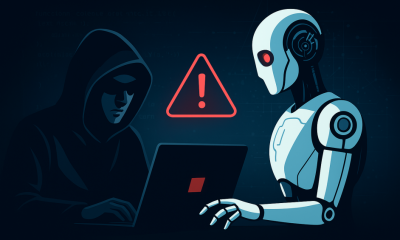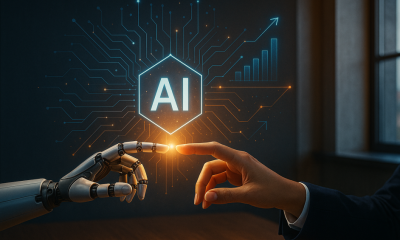思想领袖
We’ve Automated Everything Except the Actual Work: Agentic AI Can Finally Fix Execution at Scale

We’ve automated our calendars, our emails, and even our onboarding sequences. However, the actual work — the messy, human, day-to-day flow of tasks — remains stuck in chaos.
Every week, knowledge workers lose approximately 40% of their time to repeatable, low-leverage tasks, such as searching for files, copy-pasting, entering data, chasing status updates. These aren’t the activities that move the needle. And, of course, this inefficiency has a negative ripple effect. In people, it leads to burnout. In economic terms, it leads to billions of dollars in distractions and lost productivity.
Before you blame this on a “lack of tools,” think twice. The issue, from my vantage point, is that the tools we have do not work together, and never really have.
Where the system breaks
In theory, every app in your stack solves a problem. In practice, they create new ones. Often, we see employees bouncing between 12 or more platforms a day. We use Slack, Google Docs, Notion, project boards, and so on, and each of them has its own logic, login details, and learning curve.
As a result, every task becomes a tab-hopping scavenger hunt. Work gets scattered across threads and folders, and teams invent new processes every quarter just to patch the last system’s blind spots. No one has time to document, and when they do, no one reads it.
I know this because I’ve lived it. As a lean VC firm — we look at ourselves as a startup — that operates across continents and juggles multiple time zones, we’ve built our own workflows from the ground up. Early on, we created a custom deal flow engine and set strict rituals, including weekly calls, regular reviews, and quarterly in-person meetings. These systems have helped us run fast with a small team. But even then, I’ve felt the weight of tool overload.
We’ve carried that insight into our investment philosophy. Our portfolio includes companies like WalkMe, which helps teams streamline digital adoption and identify potential friction points in internal workflows.
Yet, in the world at large, we continued to see one consistent issue. The most important work, such as training, delegation, and judgment calls, still lives scattered between Slack DMs, calendar invites, and off-the-cuff Loom videos.
From tools to tension
Despite advancements in automation, most teams still rely on manual handoffs. There’s no central source of truth. Processes can break if someone critical leaves, and when something goes wrong, it is easier to redo a task than figure out how it was done the last time.
This type of system does not scale, and given today’s fast-paced environment, it is no longer sustainable.
We’re now at the edge of a shift. Thanks to multimodal AI models that can parse text, images, video, and audio, we’re entering an era where software can “watch” you work and start to understand what’s happening without needing perfect inputs. This software recognizes context, detects repetition, and gets exponentially smarter.
A bigger shift is underway
The coming decade of work is unlikely to be about choosing a “better” app or stack of tools. What will define it is what ends up replacing many of the apps altogether. Advances in multimodal artificial intelligence, the growth of unstructured workplace data (often called grey data), the steady spread of software-as-a-service tools, and the expansion of the creator economy are pushing toward a single direction: an operating system for work that is proactive, adaptive, and AI-native.
Signs of that shift are already visible. More people now skip individual apps and move straight to outcomes, such as asking an AI assistant to prepare a report, triggering automated chains to publish content, or simply describing a goal and letting software carry it out. In this model, the interface recedes and the result becomes the product.
发生了什么变化
A new generation of software is emerging, shifting from rule-based automation to adaptive, harmonious coordination and AI-native orchestration. New Agentic AI tools move from reactivity to proactivity. Yes, this means they actually take initiative.
In this regard, three patterns illustrate this shift:
- Teams want outcomes, not interfaces. People don’t want yet another dashboard — they want less to worry about. The best tools are the ones you barely notice.
- Automation is shifting, as discussed, from simply responding to leading. The real leap lies in background orchestration that is quiet, useful, and invisible. The next generation of tools won’t wait for input. Instead, they’ll observe how you work, and begin to anticipate what needs to happen next.
- Personalization is becoming standard. No two teams work the same way. Hence, the systems of the future will learn and adjust instead of enforcing rigid templates. Think about your own, proprietary operating system.
Execution over conversation
The next wave of automation is about execution. Most software still waits for people to click through menus or type commands. New systems, instead, can watch how a task is done, spot the repeated steps, and carry them out on their own. A team might record a single walkthrough, including a screen recording and a short narration, and the software captures the process, updates it as conditions change, and runs it automatically.
Personal operating systems
No two people or teams work the same way, and the systems of the future will respect that reality. Each knowledge worker will have a personal productivity model: software that learns their habits, rhythms, and preferences, then anticipates what needs to happen next. In this regard, execution stops being a brittle checklist and becomes an evolving partnership between human judgment and AI initiative.
前进的道路
To build for the future of work, we need to change how we think about software. Instead of looking at it as a collection of tools, we must view it as an environment that adapts to how people operate, even if it is imperfectly, asynchronously, and often without documentation.
In fact, the messy, unstructured layer — conversations, screen recordings, voice notes, and quick messages — is where the real work happens, and where a company’s true operating DNA lives. Agentic systems are built to understand and support that, and to work alongside people as real partners in execution.
Execution, here, can be the overlooked bottleneck. Scaling a company still means documenting hundreds of processes, duct-taping tools together, and training people in workflows that break silently with every change. Agentic AI offers a way out. Through software that understands context, acts proactively, and adapts as fast as the business evolves, it delivers on the real promise of automation, which is freeing people to focus on judgment, creativity, and the decisions that only humans can make.
这种转变 需要时间. It will take trust. And it will require companies to resist the temptation of solving complexity with more complexity. But the outcome, if done right, is worth it.












